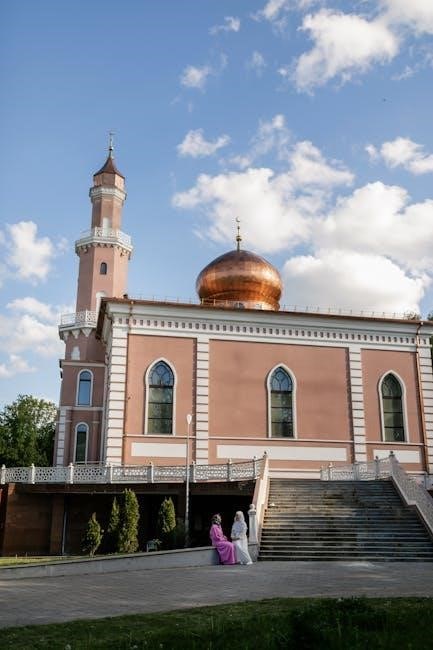The 40 Day Prayer for the Dead is a traditional devotion to honor and seek eternal rest for the departed. It involves daily prayers, reflections, and rituals like the Holy Rosary, aiming to provide spiritual support for the deceased and comfort for the grieving family. This period is believed to assist the soul’s journey, reflecting deep cultural and religious beliefs about the afterlife.
1.1 Overview of the 40 Day Prayer Tradition
The 40 Day Prayer for the Dead is a devout practice observed by many, particularly in Catholic and Filipino Catholic traditions. It involves daily prayers and reflections for 40 consecutive days after a loved one’s passing. This tradition is rooted in the belief that the soul undergoes a transitional period before entering eternal life. The prayers, including the Holy Rosary, are offered to seek relief for the deceased and to support their journey. Families and communities come together to honor the departed, fostering a sense of unity and spiritual solidarity. This practice is deeply embedded in cultural and religious customs, providing comfort to the grieving while emphasizing the importance of intercession for the dead.
1.2 Significance of the 40 Day Period in Mourning Rituals
The 40 day period holds profound significance in mourning rituals, particularly in Catholic and Filipino Catholic traditions. It is believed that the soul remains on earth for 40 days after death, seeking guidance through prayers before transitioning to the afterlife. This period is considered crucial for offering spiritual support to the deceased, helping their journey toward eternal rest. Families and communities observe this tradition to honor their loved ones, fostering a sense of unity and shared grief. The 40-day devotion also provides a structured way to cope with loss, offering comfort and closure to the bereaved. It reflects a deep belief in the power of prayer to aid the departed and bring solace to those who mourn.
Cultural and Religious Significance of the 40 Day Prayer
The 40 Day Prayer is deeply rooted in Catholic and Filipino Catholic traditions, reflecting beliefs about the soul’s journey after death. It emphasizes the use of specific prayers and rituals, such as the Holy Rosary, to guide the deceased toward eternal rest. This devotion highlights the communal aspect of mourning, where families and communities come together to honor their loved ones and seek spiritual support. The tradition underscores the importance of faith in comforting the grieving and aiding the soul’s transition, making it a vital part of cultural and religious heritage.

2.1 Roots in Catholic and Filipino Catholic Traditions
The 40 Day Prayer for the Dead has deep roots in Catholic traditions, particularly within Filipino Catholic practices. It is believed that the soul spends 40 days on earth before transitioning to the afterlife, during which prayers and Masses are offered to aid its purification. This devotion is influenced by Catholic teachings on purgatory and the importance of intercession for the deceased. Filipino Catholics have embraced this tradition, incorporating it into their mourning rituals. The prayer period is often marked by daily Rosary recitations, novenas, and Mass intentions, reflecting a strong communal and familial bond with the departed. This practice underscores the Catholic belief in the continued connection between the living and the dead, emphasizing the role of prayer in guiding the soul toward eternal rest.

2.2 Beliefs About the Soul’s Journey After Death
The 40 Day Prayer for the Dead is rooted in the belief that the soul undergoes a transitional period after death, seeking purification before entering eternal rest. Many traditions, including Catholic and Filipino practices, hold that the soul remains on earth for 40 days, during which it is vulnerable and in need of prayerful support. This belief is tied to the concept of purgatory, where the soul is cleansed of earthly sins. Prayers during this period are thought to alleviate the soul’s suffering and expedite its journey to heaven. The living are encouraged to intercede for the deceased through prayer, Masses, and rosaries, believing these acts of devotion provide comfort and guidance to the soul; This belief system offers solace to the grieving, fostering a sense of connection and purpose during mourning.
Structure of the 40 Day Prayer
The 40 Day Prayer involves daily devotions, reflections, and specific rituals, traditionally lasting 40 days to honor the deceased and support their soul’s journey. It includes structured prayers and Rosary recitations, designed to bring comfort to the grieving family while seeking eternal rest for the departed.
3.1 Daily Prayers and Reflections
Daily prayers and reflections are central to the 40 Day Prayer tradition. Each day focuses on specific devotions, seeking eternal rest for the deceased. These prayers often include recitations of the Eternal Rest Prayer, Hail Marys, and other traditional Catholic prayers. Reflections may involve meditating on the life of the departed, their virtues, and memories, fostering a deeper spiritual connection. The daily structure is designed to provide consistency and comfort, helping the family navigate their grief while interceding for the soul’s purification. This practice emphasizes faith and hope, believing that continual prayer aids the deceased in their journey toward eternal peace; The discipline of daily prayer also strengthens the spiritual well-being of those praying.
3.2 Role of the Holy Rosary in the 40 Day Devotion
The Holy Rosary holds a significant place in the 40 Day Prayer for the Dead, serving as a powerful devotion to intercede for the departed soul. This traditional Catholic prayer, comprising decades of Ave Marias and meditations on the life of Christ, is often recited daily during the mourning period. The Rosary is believed to offer solace to the grieving family while assisting the soul in its journey toward purification. Its repetitive and contemplative nature provides a sense of comfort and spiritual focus, helping to ease the pain of loss. By praying the Rosary, the faithful seek to honor the deceased and implore divine mercy for their eternal rest, aligning with the broader intentions of the 40 Day Prayer tradition.

Benefits of Observing the 40 Day Prayer
Observing the 40 Day Prayer provides spiritual support for the deceased, aiding their journey, while offering comfort and healing to the grieving family, fostering peace and hope.
4.1 Spiritual Support for the Deceased
The 40 Day Prayer is believed to provide spiritual support for the deceased, aiding their journey through purgatory and into eternal life. Through daily devotions, including the Holy Rosary and specific prayers like the Eternal Rest Prayer, the faithful intercede for the soul, seeking relief from suffering. This period is thought to be crucial, as it is believed the soul remains on earth, needing guidance and prayers to navigate its path; By offering these prayers, the living express their love and solidarity, helping the deceased find peace and strength. The devotion reflects a deep belief in the power of prayer to assist the soul in its transition, ensuring it reaches its eternal rest unimpeded.
4.2 Comfort and Healing for the Grieving Family
The 40 Day Prayer offers profound comfort and healing to the grieving family, providing solace during their time of loss. By engaging in daily prayers and communal rituals, families find emotional and spiritual support, fostering a sense of connection to their loved one. The structured devotion helps process grief, offering hope and reassurance of eternal life. Sharing these prayers collectively strengthens family bonds and provides a shared purpose, easing the pain of separation. The tradition also reminds the mourners of their own mortality, encouraging reflection on life’s fleeting nature and the importance of living virtuously. This communal practice becomes a source of strength, helping families navigate their sorrow with faith and resilience.

Key Prayers and Rituals Included in the 40 Day Devotion
The 40 Day Devotion includes the Holy Rosary, daily prayers, and the Eternal Rest Prayer, with Novenas offered for the soul’s guidance and peace.
5.1 Eternal Rest Prayer and Other Specific Prayers
The Eternal Rest Prayer is a central part of the 40 Day Devotion, seeking eternal peace for the deceased. It begins with “Eternal rest grant unto them, O Lord, and let perpetual light shine upon them.” This prayer, often recited daily, is accompanied by other specific prayers like the Prayer for the Souls in Purgatory and the Memorial Prayer. These prayers are believed to assist the soul’s purification and transition to eternal life. Additionally, the Prayer of Intercession is offered, asking for God’s mercy and guidance. These specific prayers are deeply rooted in tradition and are often included in the 40 Day Prayer for the Dead PDF, providing a structured way to honor and support the departed during their journey.
5.2 Novenas and Mass Intentions for the Deceased
Novenas, nine consecutive days of prayer, are often incorporated into the 40 Day Prayer for the Dead to intensify intercession for the soul. Families may request Mass Intentions, where Masses are offered for the deceased, believed to bring spiritual relief and grace. These practices are rooted in the belief that prayer and sacrifice can aid the soul’s purification. The 40 Day Prayer for the Dead PDF often includes Novenas and Mass Intentions as essential components, providing a structured way to honor the departed. By offering these prayers, families express love, faith, and hope for the deceased’s eternal rest, while also finding comfort in their own grieving process.
The 40 Day Prayer for the Dead remains a profound tradition, offering comfort and hope to both the deceased and the grieving. Its enduring impact lies in its ability to provide spiritual support and foster a deeper connection with faith and loved ones. This devotion continues to be a meaningful way to honor and remember those who have passed, ensuring their memory lives on in prayer and reflection.
6.1 The Enduring Impact of the 40 Day Prayer Tradition
The 40 Day Prayer for the Dead holds profound significance, offering solace to grieving families and spiritual support for the deceased. This tradition, rooted in faith, provides a structured way to honor loved ones, fostering a sense of connection and hope. By dedicating 40 days to prayer, individuals ensure the soul’s journey is guided, reflecting beliefs in the afterlife and purification. The practice strengthens communal bonds, as families and communities unite in prayer, sharing grief and finding healing. Its enduring impact lies in its ability to transcend time, comforting the living while uplifting the departed. This devotion remains a timeless expression of love, faith, and remembrance.



